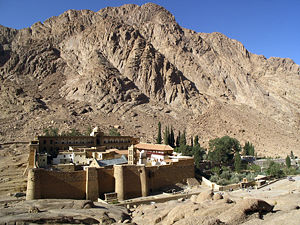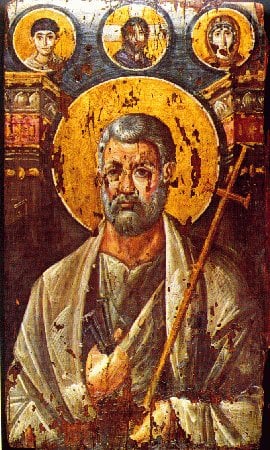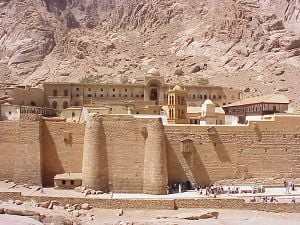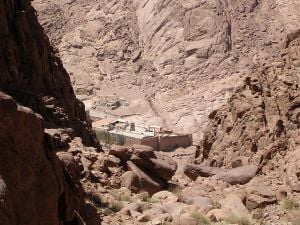Saint Catherine's Monastery, Mount Sinai
| header 1 | header 2 | header 3 |
|---|---|---|
| row 1, cell 1 | row 1, cell 2 | row 1, cell 3 |
| row 2, cell 1 | row 2, cell 2 | row 2, cell 3 |
| Saint Catherine Area* | |
|---|---|
| UNESCO World Heritage Site | |

| |
| State Party | |
| Type | Cultural |
| Criteria | i, iii, iv, vi |
| Reference | 954 |
| Region** | Arab States |
| Inscription history | |
| Inscription | 2002 (26th Session) |
| * Name as inscribed on World Heritage List. ** Region as classified by UNESCO. | |
Saint Catherine's Monastery (Greek: Μονὴ τῆς Ἁγίας Αἰκατερίνης) on the Sinai Peninsula, at the mouth of an inaccessible gorge at the foot of Mount Sinai in Egypt is one of the oldest continuously functioning Christian monasteries in the world. The monastery is Greek Orthodox and is a UNESCO World Heritage Site.
History
The oldest record of monastic life at Sinai comes from the travel journal written in Latin by a woman named Egeria about 381-384. She visited many places around the Holy Land and Mount Sinai, where, according to the Hebrew Bible, Moses received the Ten Commandments from God.[1]
The monastery was built by order of Emperor Justinian I between 527 and 565, enclosing the Chapel of the Burning Bush ordered to be built by Helena, the mother of Constantine I, at the site where Moses is supposed to have seen the burning bush; the living bush on the grounds is purportedly the original. The site is sacred to Christianity and Islam.
Though it is commonly known as Saint Catherine's, the full, official name of the monastery is, The Sacred and Imperial Monastery of the God-Trodden Mount of Sinai, and the patronal feast of the monastery is the Transfiguration. The site was associated with St. Catherine of Alexandria (whose relics were purported to have been miraculously transported there by angels) and it became a favorite site of pilgrimage.
Catherine of Alexandria was a Christian martyr initially sentenced to death on the wheel. However, when this failed to kill her, she was beheaded. According to tradition, angels took her remains to Mount Sinai. Around the year 800, monks from the Sinai Monastery found her remains.

According to the Charter of Privileges, a document in the possession of the monastery purportedly signed by Muhammad himself, Muhammed gave his protection to the monastery. A Fatimid mosque was built within the walls of the monastery, but has never been used since it is not correctly oriented towards Mecca.
During the seventh century, the isolated Christian anchorites of the Sinai were eliminated: only the fortified monastery remained. The monastery is still surrounded by the massive fortifications that have preserved it. Until the twentieth century, access was through a door high in the outer walls. From the time of the First Crusade, the presence of Crusaders in the Sinai until 1270 spurred the interest of European Christians and increased the number of intrepid pilgrims who visited the monastery. The monastery was supported by its dependencies in Egypt, Palestine, Syria, Crete, Cyprus and Constantinople.
About the monastery
The monastery library preserves the second largest collection of early codices and manuscripts in the world, outnumbered only by the Vatican Library. Its strength lies in Greek, Coptic, Arabic, Armenian, Hebrew, Georgian, and Syriac texts. The Codex Sinaiticus, now in the British Library, left the monastery in the 19th century for Russia, in circumstances that are now disputed.[2]
The complex houses irreplaceable works of art: mosaics, the best collection of early icons in the world, many in encaustic, as well as liturgical objects, chalices and reliquaries, and church buildings. The large icon collection begins with a few dating to the 5th (possibly) and 6th centuries, which are unique survivals, the monastery having been untouched by Byzantine iconoclasm, and never sacked. The oldest icon on an Old Testament theme is also preserved there. A project to catalogue the collections has been ongoing since the 1960s.
The monastery along with several dependencies in the area constitute the entire Orthodox Church of Mount Sinai, headed by an archbishop, who is also the abbot of the monastery. The exact administrative status of the church within Eastern Orthodoxy is ambiguous: by some, including the church itself, [3] it is considered autocephalous,[4] [5] by others an autonomous church under the jurisdiction of the Greek Orthodox Church of Jerusalem.[6] The archbishop is traditionally consecrated by the Orthodox Patriarch of Jerusalem; in recent centuries he has usually resided in Cairo. During the period of the Crusades, marked by bitterness between the Orthodox and Catholic churches, the monastery was patronized by both the Byzantine Emperors and the rulers of the Kingdom of Jerusalem, and their respective elites. The monastery was an important centre for the development of the hybrid style of Crusader art, and still retains over 120 icons created in the style, by far the largest collection in existence. Many were evidently created by Latins, probably monks, based in or around the monastery in the 13th century.[7]
Coordinates:
ReferencesISBN links support NWE through referral fees
- ↑ Pilgrimage of Etheria text at ccel.org
- ↑ Oldest complete canon considered stolen
- ↑ The official Website describes the Church as "διοικητικά "αδούλωτος, ασύδοτος, ακαταπάτητος, πάντη και παντός ελευθέρα, αυτοκέφαλος" or "administratively 'free, loose, untresspassable, free from anyone at any time, autocephalous'" (see link below)
- ↑ Weitzmann, Kurt, in: Galey, John; Sinai and the Monastery of St. Catherine, p. 14, Doubleday, New York (1980) ISBN 0385171102
- ↑ Ware, Kallistos (Timothy) (1964). Part I: History. The Orthodox Church. Penguin Books. Retrieved 2007-07-14. Under Introduction Bishop Kallistos says that Sinai is "autocephalous"; under The twentieth century, Greeks and Arabs he states that "There is some disagreement about whether the monastery should be termed an 'autocephalous' or merely an 'autonomous' Church."
- ↑ The Orthodox Church of Mount Sinai CNEWA Canada, "A papal agency for humanitarian and pastoral support"
- ↑ Kurt Weitzmann in The Icon, Evans Brothers Ltd, London (1982), pp. 201-207 (trans. of Le Icone, Montadori 1981), ISBN 0237456451
See also
- Archbishop of Mount Sinai and Raithu
- Codex Sinaiticus
- Apology of Aristides
- Charnel House
- Hermit
- Poustinia
- Eastern Christianity
- Byzantine Discalced Carmelites
- Mary of Egypt
- Macarius of Egypt
- Christ Pantocrator
- Kurt Weitzmann
- Sümela Monastery
- Saint John Climacus
- Ladder of Divine Ascent
- Monastery of Saint Anthony, the oldest monastery
- Gregory of Sinai
External links
- Official Website of the Holy Monastery of St. Catherine at Mount Sinai
- St. Catherine's Monastery, Sinai, Egypt
- Camberwell/St.Catherine's Project
- Holy Image, Hallowed Ground: Icons from Sinai Getty exhibit
- Early Icons from Sinai, Belmont U
- St. Catherine's Monastery (Sinai) (OrthodoxWiki article)
- The text of the Charter from Muhammad can be read here or here.
- At a Mountain Monastery, Old Texts Gain Digital Life article from New York Times
- Information about the town of St. Katherine
- The Physical Components of the Monastery
- The Icons of St. Catherine's—Gallery
- Gallery of Artifacts in the Monastery's Collection
- [[wikisource:Catholic Encyclopedia (1913)/Monastery of Saint Catherine "|Monastery of Saint Catherine]".] Catholic Encyclopedia. (1913). New York: Robert Appleton Company.
Template:Orthodoxy
| 60px | |
|---|---|
|
Patriarchates | |
Template:World Heritage Sites in Egypt
ar:دير سانت كاترين
frp:Égllése ortodoxe du Sinayi
bg:Синайски манастир
ca:Monestir de Santa Caterina del Sinaí
cs:Klášter svaté Kateřiny
de:Katharinenkloster (Sinai)
es:Monasterio de Santa Catalina del Monte Sinaí
fa:صومعه سنت کاترین
fr:Monastère Sainte-Catherine du Sinaï
it:Monastero di Santa Caterina
he:מנזר סנטה קתרינה
ka:წმ. ეკატერინეს მონასტერი (სინაი)
nl:Katharinaklooster
ja:聖カタリナ修道院
no:Katarina-klosteret
pl:Klasztor świętej Katarzyny
pt:Mosteiro Ortodoxo de Santa Catarina
ru:Монастырь Святой Екатерины
fi:Pyhän Katariinan luostari
sv:Katarinaklostret
zh:圣凯瑟琳修道院 (西乃山)
Credits
New World Encyclopedia writers and editors rewrote and completed the Wikipedia article in accordance with New World Encyclopedia standards. This article abides by terms of the Creative Commons CC-by-sa 3.0 License (CC-by-sa), which may be used and disseminated with proper attribution. Credit is due under the terms of this license that can reference both the New World Encyclopedia contributors and the selfless volunteer contributors of the Wikimedia Foundation. To cite this article click here for a list of acceptable citing formats.The history of earlier contributions by wikipedians is accessible to researchers here:
The history of this article since it was imported to New World Encyclopedia:
Note: Some restrictions may apply to use of individual images which are separately licensed.


